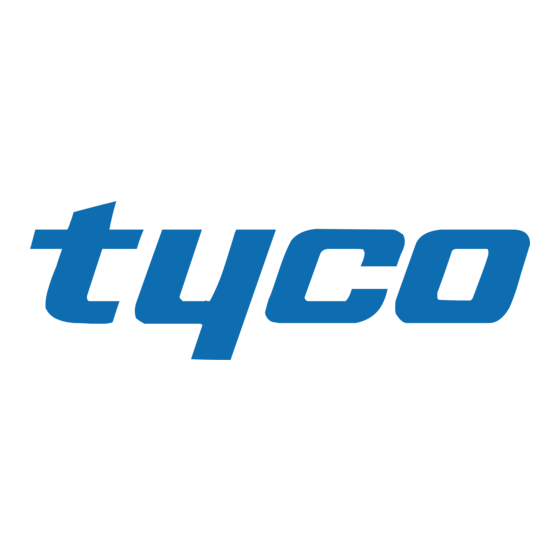
Advertisement
Quick Links
Type HV High Velocity
Directional Spray Nozzles,
Open, Non-Automatic
General
Description
The TYCO Type HV Nozzles are open
(non-automatic)
directional
nozzles with individual inlet strainers.
They are designed for use in water
spray fixed systems for fire protection
applications where a high velocity water
application may be required, such as
for the protection of flammable liquids.
The Type HV Nozzles feature an integral
strainer for use when the authority
having jurisdiction (other than NFPA
applications) requires the use of indi-
vidual strainers in addition to main
pipeline strainers for nozzles having an
orifice diameter of 3/16 inch (4,8 mm)
or less.
Available in brass or stainless steel, the
six patterns of the Type HV Nozzles
provide a wide variety of orifice sizes
and distribution characteristics. As
water passes through the internal swirl
plate, a swirling action is produced,
prior to the water being discharged
through the orifice tip of the body,
resulting in a solid conical spray pattern
of water droplets being discharged over
a defined area.
High velocity type nozzles are princi-
pally used in water spray systems for
the protection of fixed hazards such as
transformers, circuit breakers, diesel
engines and diesel storage tanks,
turbo alternators, lube oil systems, oil
fire boilers, and similar hazards. They
are capable of rapidly extinguishing
oil fires by emulsification, cooling, and
IMPORTANT
Always refer to Technical Data
Sheet TFP700 for the "INSTALLER
WARNING" that provides cautions
with respect to handling and instal-
lation of sprinkler systems and
components. Improper handling and
installation can permanently damage
a sprinkler system or its compo-
nents and cause the sprinkler to fail
to operate in a fire situation or cause
it to operate prematurely.
Page 1 of 6
smothering. The surface cooling effects
of high velocity type nozzles also
minimizes the possibility of reignition
after a fire extinguishment.
It is recommended that the end user be
spray
consulted with respect to the suitability
of the materials of construction for any
given corrosive environment. Effects of
ambient temperature, concentration of
chemicals, and gas/chemical velocity
should be considered, at a minimum,
along with the corrosive nature to which
the nozzles may be exposed.
The TYCO Type HV Nozzles are a
redesignation for the Gem Type HV.
NOTICE
The TYCO Type HV Nozzles described
herein must be installed and main-
tained
in
compliance
document, as well as with the appli-
cable standards of the National Fire
Protection Association, in addition to
the standards of any other authorities
having jurisdiction. Failure to do so
may impair the performance of these
devices.
The design of individual water spray
fixed systems can vary considerably,
depending on the characteristics and
nature of the hazard, the basic purpose
of the spraying system, the configu-
ration of the hazard, and wind/draft
conditions. Because of these variations
as well as the wide range of available
nozzle spray characteristics, the design
of water spray fixed systems for fire
protection must only be performed by
experienced designers who thoroughly
understand the limitations as well as
capabilities of such systems.
AUGUST 2013
Worldwide
Worldwide
Contacts
Contacts
The owner is responsible for main-
taining their fire protection system and
devices in proper operating condition.
The installing contractor or sprinkler
manufacturer should be contacted with
any questions.
with
this
www.tyco-fire.com
www.tyco-fire.com
TFP815
Advertisement

Subscribe to Our Youtube Channel
Summary of Contents for Tyco HV
- Page 1 The surface cooling effects of high velocity type nozzles also Description minimizes the possibility of reignition after a fire extinguishment. The TYCO Type HV Nozzles are open It is recommended that the end user be (non-automatic) directional spray consulted with respect to the suitability nozzles with individual inlet strainers.
-
Page 2: Technical Data
(LPM / √bar) Approvals 2.83 1.87 1.50 1.30 HV-14 23,0 (71,9) (47,1) (38,1) (33,0) The Type HV Nozzles are UL and cUL Listed, as well as FM Approved 2.83 1.87 1.50 1.30 HV-17 25,9 (71,9) (47,1) (38,1) (33,0) Maximum Working Pressure 2.83... - Page 3 OVERALL SPRAY PATTERN (RADIAL DISTANCE) DESIGN SPRAY PROFILE (S/2) METERS FEET METERS FEET HV-14 HV-26 METERS FEET METERS FEET HV-60 HV-17 METERS FEET METERS FEET HV-37 HV-45 FIGURE 2 — PART 1 OF 2 TYPE HV NOZZLES WATER DISTRIBUTION DESIGN DATA...
- Page 4 ( owing) pressure range at the nozzle inlet of 30 to 80 psi (2,1 to 5,5 bar). For pressures up to 175 psi (12,1 bar), consult Tyco Fire Suppression & Building Products Technical Services. DESIGN 3. The shapes of the Overall Spray...
-
Page 5: Installation
Type Type HV Nozzles are given in Figure 2 HV Nozzles, since their waterways are Before closing a fire protection system for residual (flowing) pressures of 30 less than 3/8 inch (9,5 mm) diameter. -
Page 6: Ordering Procedure
Brass Assemblies, ISO 7/1 Service in accordance with local HV-14 ....P/N PBP55062 requirements and/or national codes. HV-17 ....P/N PBP55071 HV-26 .




Need help?
Do you have a question about the HV and is the answer not in the manual?
Questions and answers